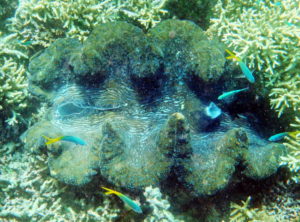
One of dozens of healthy giant clams on Kelso Reef, May, 15, 2022, Great Barrier Reef Marine Park ©Craig Thomas
June 25, 2022
A couple recently expressed their regret to me about missing their chance to see Australia’s Great Barrier Reef because now it’s dead. But it’s not yet time to write off this 1,500-mile-long wonder of the world. It’s true that parts are in trouble, and it’s difficult to get to the reefs that are still thriving, but the Great Barrier Reef has much left to amaze and protect.
Craig and I spent a good part of last month on a sailing trip to the reefs of the central Great Barrier Reef Marine Park outside of Townsville, where coral bleaching was recently reported for the first time.
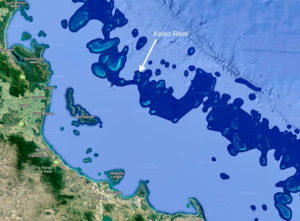
Townsville lower center, inshore of Magnetic Island. Arrow is Kelso Reef.
And, yes, we saw white patches on about 10 percent (our estimate) of the corals there. Overall, though, the marine life on that reef was splendid to behold.
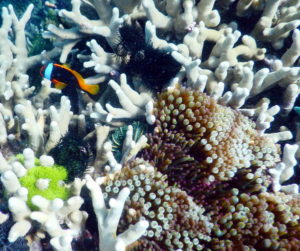
A clownfish ventured from its bubble anemone amid several feather stars (the black and green spiky creatures, also called crinoids.) The finger coral in this picture is healthy, a light tan, not bleached. ©Susan Scott
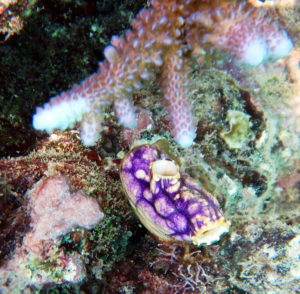
These purple-and-yellow sea squirts, AKA tunicates, dotted Kelso reef. The tips of the corals above this tunicate have lost their pink algae (i.e. are bleached), but will hopefully recover with cooler winter waters. ©Susan Scott
We had a rare flat-water, no-wind trip to this outer reef, motoring our 37-foot-long sailboat, Honu for about 8-hours. We always laugh when we get to the famous outer reefs because there’s nothing to see except various shades of blue, meaning danger. Even with GPS maps, exploring Australia’s barrier reef is nerve-wracking.
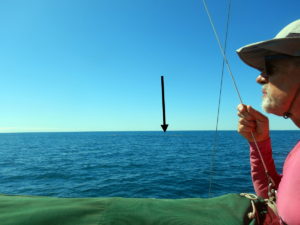
Craig on the deck looking for coral heads. The arrow points to one, visible at this time of day but impossible to see in low light. ©Susan Scott
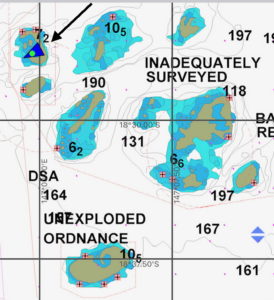
The arrow on this GPS map on Craig’s phone points to where we anchored Honu in Kelso Reef. Getting there in a sailboat is slow, intense obstacle course. ©Craig Thomas
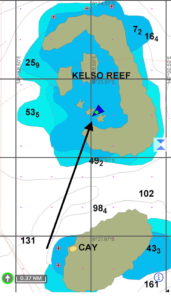
The GPS map detail of Kelso Reef. This is as much detail as is available. Endless smaller coral heads inside are uncharted. ©Craig Thomas
After an hour or so of picking our way around coral heads, we dropped anchor, launched the dinghy, and went snorkeling. All of this we did promptly, at high sun, in case wind, waves, or rain came up. If that happens, we must up-anchor immediately, hope for good enough visibility to get back into deep water, and then sail another 6-to-8 hours to shelter behind the Palm Islands.
But, oh, it is so worth the worry. Almost immediately after getting in the water, we saw three species of reef sharks: whitetip, blacktip and gray, all adults about 6 feet long. Each came separately to check out what was splashing around in their turf. When they saw we were nothing to eat, they quickly lost interest and left.
A remarkable number of fish swam among Kelso’s corals, both in the variety of species and in the density of their schools. Besides marveling over the sheer number of fish out there, the highlight of our day was watching a curled-up feather star (also called a crinoid) practically sprinting across a coral head.
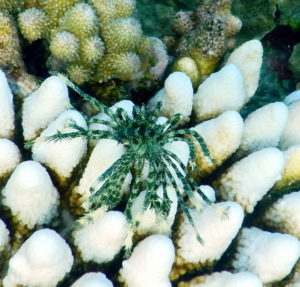
This feather star was moving over a bleached coral head as fast as we’ve ever seen one move. We would not likely have seen this if the coral was its normal healthy color (top of photo.) ©Susan Scott
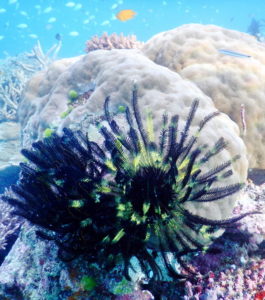
A feather star perched on a healthy coral head. The star’s arms are wide open to catch passing plankton. Schools of damselfish swim in the background. ©Susan Scott
We spent the night at Kelso Reef, uneasy about our open-ocean exposure and the nearness of several coral heads. With a thunderstorm looming, we waited until the sun rose high enough to see the coral, and left for the protection of the Palm Islands. There, to my delight, we found a wealth of pom-pom corals, my nickname for the soft red corals that line the channel between Orpheus and Fantome Islands. Given the recent reports, I was worried about these exquisite creatures. Finding my favorite pom-pom colony still so vibrant and healthy caused tears of joy to cloud my mask.

My favorite soft, red pom-pom corals are doing well. ©Susan Scott
Tears also came from knowing this was our last voyage on our beloved boat, Honu, our vehicle of adventure since 1985. The time had come to sell the boat.
Major life changes can be hard, but after Covid killed my 32-year-long newspaper column, and then kept us from Honu, moored in Australia, for so long that the boat got run down, well, decisions got made for me.
The boat sold in two days, and with that responsibility gone, I’m looking forward to new adventures, one of which is concentrating on my role as president of one of Hawai’i’s oldest conservation organizations, the Hawai’i Audubon Society.
I also look forward to exploring, and enjoying, more of this excellent place that I’m so lucky to call home. The Hawaii Islands may not be pristine, but like the Great Barrier Reef, they’re still amazing to behold and well worth working to protect. Thank you, dear readers, for sticking with me as I follow fresh winds toward new horizons.
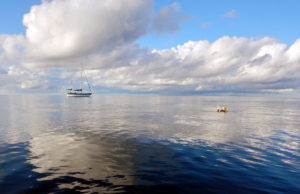
I